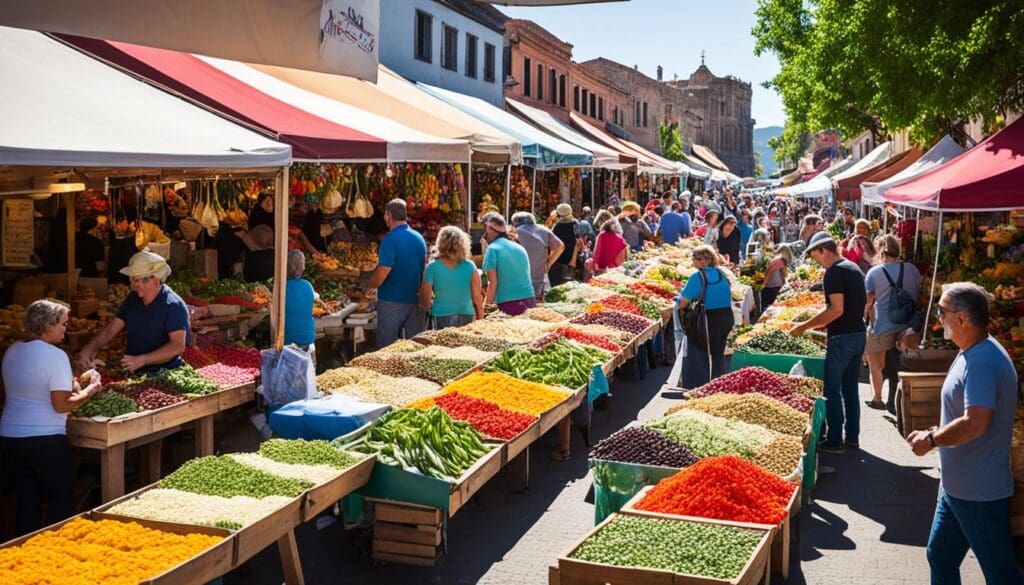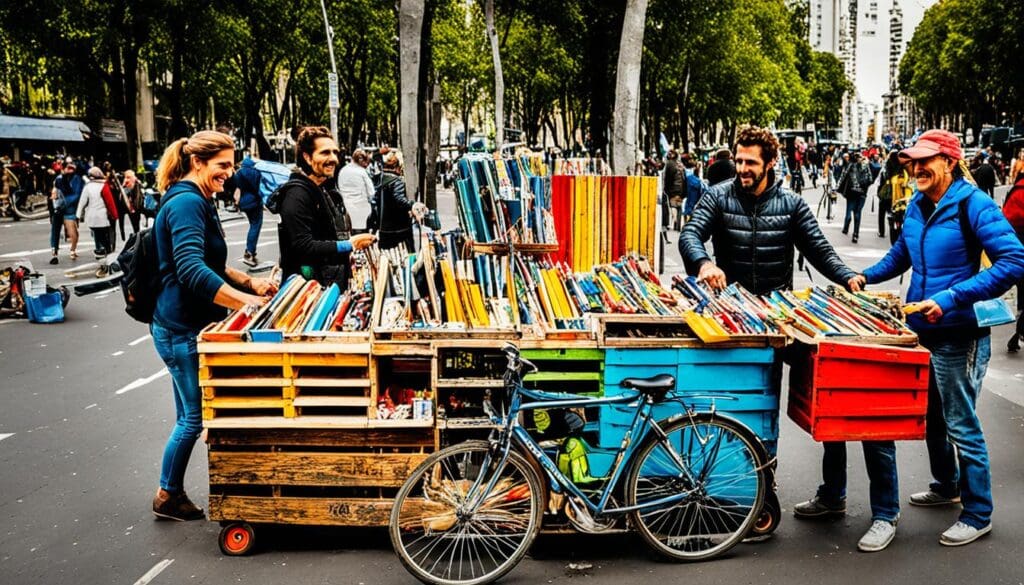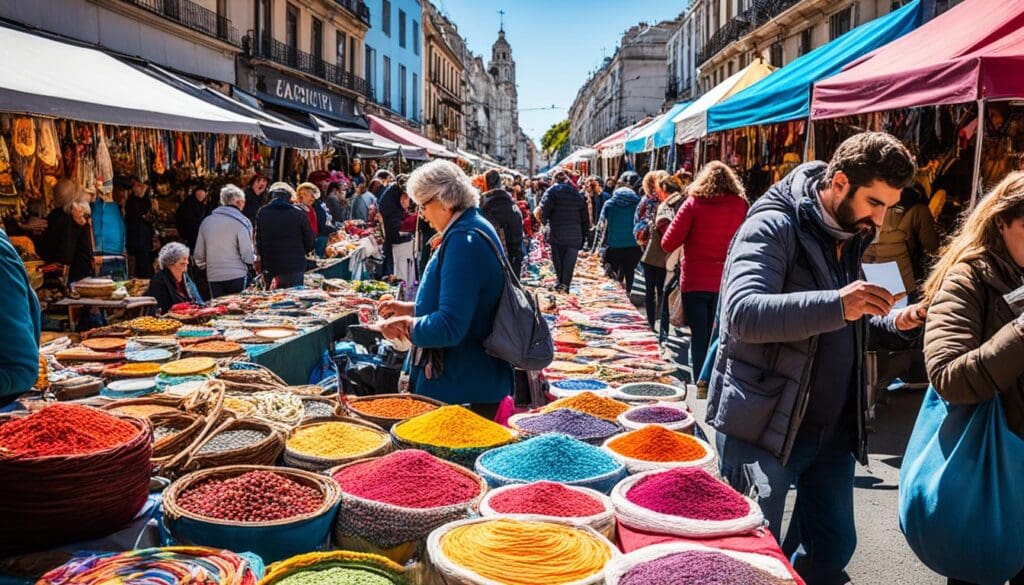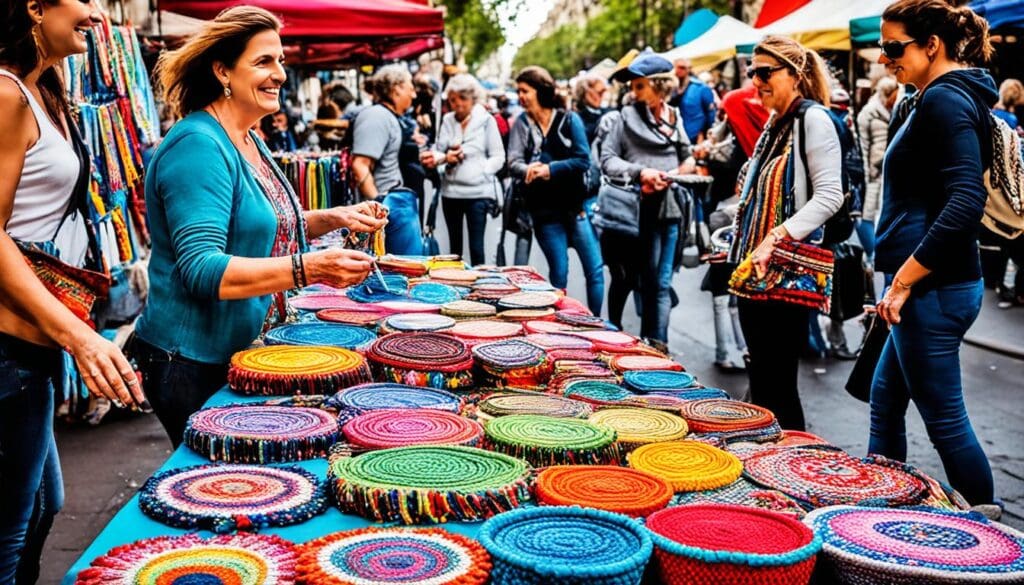

Maria Olson
At VAMOS Academy, I craft stories sprinkled with my love for exploration and food. Whether it’s the tang of a local dish or the rhythm of a new dialect, I bring these experiences to you. Ready for an adventure that tickles your taste buds and ignites your wanderlust? Let’s embark on this journey together, one story and one bite at a time.
Table of Contents
- The Cultural Significance of Street Vendors in Buenos Aires
- The Informal Markets of Buenos Aires
- The Creativity of Buenos Aires Street Vendors
- Preserving Traditional Art Forms in Buenos Aires
- Supporting the Local Economy
- The Impact of Street Vendors on Urban Aesthetics
- The Future of Buenos Aires’ Street Vendors
Have you ever wondered how street vendors in Buenos Aires manage to turn their roadside stalls into captivating displays of urban art? How they blend traditional crafts with modern creativity and breathe life into the city’s bustling markets? Discover the secret behind Buenos Aires’ vibrant street culture and explore the fascinating stories of survival and creativity that lie within the art of its street vendors.
Buenos Aires’ street vendors are cultural ambassadors, showcasing the rich heritage of the city through their unique displays of traditional crafts and artisan products. What makes their artistry particularly intriguing is the way they seamlessly blend urban art with elements of Buenos Aires’ indigenous culture, creating a visual feast that captivates locals and tourists alike.
- University Spanish Courses in Argentina
- Spanish Lessons in Malaga
- Learn Spanish in Milwaukee
- Profesores de ingles en Malaga
- Profesores de ingles en Buenos Aires
- Learn Spanish in Ottawa
- Spanish Tutor in Toronto
- Learn Spanish Online
- Argentina Student Visa
- Coorporate Spanish Classes
- Spanish Classes in Argentina
In this article, we will delve into the cultural significance of street vendors in Buenos Aires, explore the challenges they face, and celebrate their creativity in preserving traditional art forms. Join us on a journey through the colorful streets of Buenos Aires and discover why it is an ideal destination to not only learn Spanish but also experience the artistic soul of South American street vendors.
The Cultural Significance of Street Vendors in Buenos Aires
In Buenos Aires, street vendors play a crucial role in the city’s cultural landscape. They are not just ordinary sellers of goods; they are cultural ambassadors who contribute to the rich artistic heritage of Buenos Aires. These vendors showcase traditional crafts and artwork, making them an essential part of the city’s vibrant street culture.
The creative displays and unique products offered by street vendors attract both locals and tourists alike. Their stalls are filled with a variety of local artisan products, from handcrafted jewelry to intricate paintings. These artistic creations become a visual representation of Buenos Aires’ culture and form an integral part of the urban art scene that the city is known for.
Through their work, street vendors contribute to the preservation of traditional art forms and help keep Buenos Aires’ cultural heritage alive. They often specialize in crafts that have been passed down through generations, ensuring that these art forms continue to thrive in a modern and evolving city.
The Role of Street Vendors in Promoting Buenos Aires Culture
Street vendors in Buenos Aires not only showcase their own creations but also provide a platform for other local artisans to display and sell their products. By supporting these vendors, visitors have the opportunity to take home unique and authentic souvenirs that truly represent the spirit of Buenos Aires.
Additionally, street vendors contribute to the local economy by supporting small businesses and artisans. Buying from street vendors helps sustain their livelihood and ensures the continued flourishing of Buenos Aires’ artistic community.
The Unique Atmosphere of Buenos Aires’ Markets
One of the distinctive features of Buenos Aires’ street culture is the vibrant and lively atmosphere found in its markets. The presence of street vendors with their colorful stalls and artistic displays adds to the overall charm and character of these spaces. Whether it’s the bustling San Telmo Market or the trendy Feria de Mataderos, each market exudes a unique energy that captivates visitors and immerses them in the city’s culture.
List of Traditional Artisan Products at Buenos Aires’ Markets
| Product | Description |
|---|---|
| Handmade Jewelry | Artisan-crafted necklaces, bracelets, and earrings using a variety of materials such as silver, semi-precious stones, and ceramics. |
| Leather Goods | High-quality leather products including bags, wallets, belts, and accessories. |
| Mate Accessories | Ornate gourds, bombillas (the traditional mate straws), and thermal cups for enjoying Argentina’s beloved yerba mate drink. |
| Textiles | Colorful textiles, including ponchos, scarves, and blankets, woven using traditional techniques and patterns. |
| Ceramics | Hand-painted pottery, ceramic figurines, and decorative tiles showcasing traditional Argentine designs. |
These are just a few examples of the wide range of artisan products found at Buenos Aires’ markets. Each product tells a story and represents a piece of Buenos Aires’ cultural heritage.
The Informal Markets of Buenos Aires
The city of Buenos Aires is renowned for its vibrant and bustling informal markets, which play a significant role in the local culture and economy. These traditional markets are vibrant hubs where street vendors gather to sell their unique and handcrafted wares. Filled with a diverse array of goods, ranging from exquisite handmade crafts to tantalizing street food, these markets provide a platform for vendors to showcase their artistic talents and connect with customers who appreciate their one-of-a-kind offerings.
Walking through the bustling streets of Buenos Aires, one cannot help but be captivated by the colorful stalls, the enticing aromas, and the lively atmosphere that permeates these markets. The traditional markets of Buenos Aires are not just places to buy and sell; they are cultural spaces where local artisans and vendors come together to celebrate the city’s rich heritage and showcase their exceptional craftsmanship.


From the moment you step into one of these markets, you are transported into a world of creativity and tradition. The market stalls are adorned with handmade decorations and artistic displays that reflect the artistic flair of the vendors. It is a visual feast for the senses, where every corner reveals something unique and remarkable.
To further explore the world of Buenos Aires’ informal markets, let’s take a closer look at the variety of goods and experiences they offer:
1. Handmade Crafts
The informal markets of Buenos Aires are treasure troves of handmade crafts, showcasing the incredible skills and creativity of local artisans. These crafts range from intricate textiles and ceramics to delicate jewelry and leather goods. Each item tells a story and reflects the cultural heritage of Argentina, making them meaningful souvenirs or decorative pieces.
2. Artisanal Food and Beverages
Food lovers will be delighted by the array of artisanal food and beverages available in the informal markets of Buenos Aires. From traditional empanadas and choripán to alfajores and mate, there’s something to satisfy every palate. These gastronomic delights are not only delicious but also offer a taste of the local culture and culinary traditions.
3. Live Performances and Cultural Events
The markets come alive with vibrant live performances and cultural events, adding an extra layer of excitement and entertainment. It is common to find musicians playing traditional Argentine tango, street performers showcasing their skills, and artists creating live artwork. These performances and events create a dynamic and immersive experience that brings the Buenos Aires culture to life.
Visiting the informal markets of Buenos Aires is a must for those who want to experience the true essence of the city’s culture. Whether you’re looking for unique souvenirs, delicious local food, or simply a glimpse into the vibrant Buenos Aires lifestyle, these markets offer an unforgettable experience.
So, next time you find yourself in Buenos Aires, don’t miss the opportunity to explore these traditional markets and immerse yourself in the rich tapestry of Buenos Aires’ cultural heritage.
The Creativity of Buenos Aires Street Vendors
Buenos Aires’ street vendors are renowned for their exceptional craftsmanship and artistic skills. These talented individuals don’t just sell products; they create unique pieces of street art that captivate the imagination and stir the soul. From handcrafted jewelry to intricate paintings, their creations showcase a remarkable blend of urban art and artisan craftsmanship.
What sets Buenos Aires’ street vendors apart is their innate ability to infuse creativity into every aspect of their trade. Their artistry is not limited to the products they craft but extends to the way they display and present their goods. Each vendor takes pride in curating a visually captivating stall that beckons passersby to explore their collection.
The vibrant atmosphere of Buenos Aires’ markets is enhanced by the artistic flair of the street vendors. Their vibrant displays and captivating artwork act as a visual feast for the senses, drawing visitors and locals alike into the enchanting world of urban art. Walking through these markets is akin to strolling through an open-air gallery, filled with the passion and creativity of the city’s street artisans.
The creativity of Buenos Aires’ street vendors not only adds to the aesthetic appeal of the city but also plays a crucial role in preserving and celebrating its cultural identity. These artisans keep traditional art forms alive through their innovative adaptations and stunning interpretations of centuries-old techniques.
Visiting Buenos Aires’ markets is an opportunity to immerse oneself in a world where artisanal skill and urban culture converge. It’s a chance to witness firsthand the boundless creativity and passion that make the city’s street vendors true masters of their craft.
Preserving Traditional Art Forms in Buenos Aires
Street vendors in Buenos Aires play a vital role in preserving traditional art forms. They specialize in unique crafts that have been handed down through generations, showcasing the rich cultural heritage of the city. By offering these traditional artisan products, street vendors contribute to the preservation and celebration of Buenos Aires’ cultural identity.
These vendors create a platform for local artisans to showcase their skills and keep traditional art forms alive. From intricately woven textiles to hand-carved wooden sculptures, Buenos Aires’ street vendors honor the time-honored techniques and craftsmanship of their ancestors. Their dedication to preserving these traditional art forms ensures that future generations can appreciate and learn from the city’s cultural legacy.
Promoting Local Artisan Products
One of the key ways in which street vendors contribute to preserving traditional art forms is by promoting local artisan products. These vendors offer a wide range of handcrafted goods, including pottery, jewelry, leather goods, and textiles. By selling these products in traditional markets, street vendors create a direct connection between the community and the artists, fostering a sense of appreciation for the local craftsmanship.
Furthermore, street vendors often collaborate with local artisans, providing them with a platform to showcase their work and reach a wider audience. This collaboration not only supports the livelihoods of the artisans but also helps to sustain their artistic traditions by ensuring a market for their products.
Supporting the Local Economy
Street vendors in Buenos Aires play a crucial role in supporting the local economy and contributing to the livelihood of artisans and small businesses. By selling their handmade products, these vendors generate income not only for themselves but also for the wider community. When you buy from street vendors, you’re not just getting a unique and authentic souvenir; you’re also directly supporting the local economy and the vibrant Buenos Aires culture.
Local artisan products offered by street vendors reflect the city’s rich artistic heritage and cultural traditions. These intricately crafted items capture the essence of Buenos Aires, showcasing the creativity and talent of its artisans. By purchasing their products, you help sustain and preserve these traditional art forms, ensuring their continuation for future generations to admire and enjoy.


As shown in the table above, supporting street vendors not only helps sustain the local economy but also has a ripple effect on job creation, cultural preservation, and tourism. By valuing and purchasing their artisanal products, you contribute to the economic growth and vibrancy of Buenos Aires.
Next time you visit Buenos Aires, be sure to explore the city’s informal markets and engage with the talented street vendors. By supporting their businesses, you become a part of the thriving local economy and contribute to the preservation of Buenos Aires’ rich cultural heritage.
The Impact of Street Vendors on Urban Aesthetics
The artistic displays of street vendors have a profound impact on the urban aesthetics of Buenos Aires. Their colorful stalls, handmade decorations, and vibrant artwork contribute to the visual appeal of the city’s urban landscape, creating a visually stimulating environment for both residents and visitors.
Street vendors in Buenos Aires are masters of their craft, using their artistic skills to transform everyday objects into unique pieces of urban art. Whether it’s a hand-painted mural on a vendor’s stall or intricate handmade jewelry, their creations breathe life into the city streets.
One of the distinctive features of Buenos Aires’ street culture is the fusion of traditional craftsmanship with contemporary urban art. Street vendors often incorporate elements of both, blending traditional techniques with modern aesthetics. This unique combination of styles adds to the vibrant and eclectic atmosphere of the city.
In addition to their individual creations, street vendors also contribute to the overall aesthetic charm of the city by curating a diverse range of artistic displays. The markets and stalls showcase a plethora of artwork, ranging from paintings and sculptures to textiles and ceramics. The variety and quality of these artistic displays make Buenos Aires a hub for urban art enthusiasts.
Moreover, the presence of street vendors creates an immersive and interactive experience for both residents and visitors. These visual displays invite people to explore and engage with the urban landscape, fostering a sense of connection and community. The vibrant colors, intricate designs, and unique cultural motifs reflect the diversity and richness of Buenos Aires’ artistic heritage.
By supporting street vendors and their artistic endeavors, the city of Buenos Aires not only preserves its cultural identity but also cultivates a vibrant and visually inspiring environment. The integration of urban art into the fabric of everyday life enhances the city’s appeal and reinforces its status as a global cultural destination.


Exploring Cultural Influences
One of the fascinating aspects of Buenos Aires’ street vendors is the way they blend different cultural influences in their art. Whether it’s street art infused with Indigenous symbolism or traditional crafts fused with modern techniques, these vendors create pieces that are both visually stunning and culturally significant.
Here are some cultural influences you might encounter when exploring the offerings of Buenos Aires’ street vendors:
- Indigenous Traditions: Many street vendors draw inspiration from the indigenous cultures that have shaped Argentina’s history. From intricately woven textiles to traditional pottery, these vendors pay homage to the ancestral heritage of the country.
- European Influences: Buenos Aires’ history as an immigration hub has resulted in a blend of European influences. Street vendors often incorporate elements of European craftsmanship in their jewelry, ceramics, and leather goods, reflecting the city’s multicultural identity.
- African Roots: African traditions have also made a significant impact on Buenos Aires’ culture. Street vendors may showcase Afro-Argentine art forms such as drumming, dance, or vibrant textiles, providing a glimpse into the Afro-Argentine community’s cultural contributions.
By acknowledging and appreciating these diverse cultural influences, visitors can actively participate in the preservation and celebration of Buenos Aires’ unique artistic heritage.
The Future of Buenos Aires’ Street Vendors
As the vibrant street culture of Buenos Aires continues to evolve, the future of street vendors hangs in the balance. These vendors, known for their artistic displays and unique offerings, are a crucial part of the city’s cultural fabric. Striking a balance between preserving cultural traditions and adapting to modern demands is essential to ensure their continued success.
Efforts are underway to provide support and opportunities for street vendors to showcase their art and connect with customers. By creating designated spaces for their activities and organizing cultural events that celebrate their creativity, Buenos Aires aims to empower these vendors and nurture their entrepreneurial spirit.
The resilience and ingenuity of street vendors are vital in maintaining the vibrancy of Buenos Aires’ street culture. By embracing their artistic talents and recognizing their contribution to the city’s urban art scene, Buenos Aires can create an environment where street vendors thrive and continue to enrich the city’s cultural landscape for years to come.




